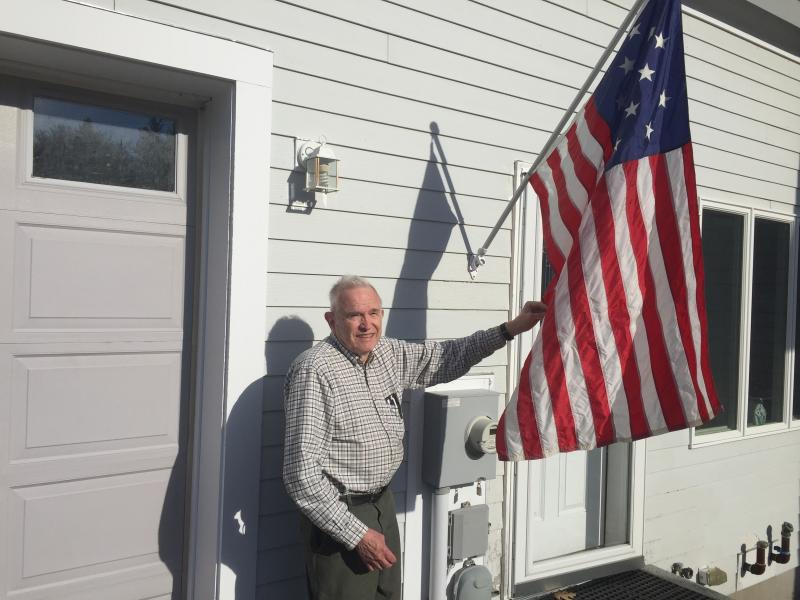Edgecomb man remembers the day Pearl Harbor was bombed
Byron Johnson witnessed history 75 years ago today. The 82-year-old Edgecomb resident was a 7-year-old living about 15 miles from the Pearl Harbor Naval Base in Honolulu, Hawaii.
Dec. 7, 1941 started like most Sunday mornings for the Johnsons. His parents were busy readying him and his two younger siblings for church. But it didn’t turn out being a typical Sunday morning. The day became “A date which will live in infamy” as President Franklin D. Roosevelt called it during a Dec. 8 national radio address seeking a declaration of war against the Empire of Japan.
The bombing began around 7:45 a.m. local time. But the Johnsons were unaware anything was different. They didn’t listen to the radio prior to leaving for church.
The first evidence something was very different about Dec. 7, 1941 occurred at the bus stop. They observed a Navy captain located further up the hill in a Ford Model A Coupe. Later, the vehicle sped off seemingly on two wheels turning along the road’s bend in front of them, according to Johnson.
As the family waited for the bus, a woman of Filipino descent emerged from her home yelling “The Japanese are attacking!” But Johnson remembers everybody thinking she meant the Japanese were attacking the Philippines, not Hawaii.
Later, his mother commented about seeing a large plume of black smoke coming from the western horizon. She surmised the smoke came from the sugar cane fields. But Johnson remembers sugar cane smoke was white.
The Johnsons never made it to church that day. His father, Byron, Sr., a civilian contractor, boarded the bus and headed for the Pearl Harbor Naval Base. His mother took Byron, Jr. and his siblings back to the house. Young Byron wasn’t sure the island was under attack until he looked skyward. He saw two strange planes overhead. Neither fired ammunition or dropped any bombs. He believes the planes were lost and looking to regroup with their squadron.
“I looked up and saw two shiny planes. I knew it wasn’t one of ours because we didn’t have anything that modern and the planes also had two giant painted red circles,” he said.
Prior to the Pearl Harbor bombing, the Johnsons knew about the war in Europe and the Japanese Empire’s invasion of other Asian countries and South Pacific Islands. The Johnsons listened to a shortwave radio detailing the European War.
In the summer of 1941, Byron, Sr., a civil engineer, was hired to work on the island’s infrastructure. He spoke French and German and traveled to Europe following his 1931 college graduation. When World War II began, Byron Sr. updated troop movements by placing pins on a map of Europe after listening to radio updates.
Young Byron listened too, but he didn’t comprehend the French and German speakers talking on the short wave radio. “I didn’t understand much especially from the wild characters ranting and raving in German,” he said.
The Johnsons and other Hawaiian inhabitants were unaware in December 1941 the U.S. would also join the ongoing European and Pacific wars. According to Johnson, the inhabitants of the Hawaiian Islands didn’t realize problems existed between the U.S. and Japanese Empire.
“We knew about the Japanese attacking other Asian nations, but that was all. It took us by surprise when they bombed Pearl Harbor,” Johnson said.
According to encyclopedia.com, the attack on the U.S. Pacific fleet was intended to give Japan time to fortify its newly conquered territories. On Dec. 7, 1941, the Japanese also attacked British forces in Hong Kong and in the Malay peninsula, and U.S. forces on Midway Island and in Guam and the Philippines. At Pearl Harbor, 351 Japanese fighter, bombers, and torpedo planes sunk or disabled 19 ships, destroyed 164 U.S. aircraft and damaged 128; 2,335 Americans died and 1,178 were wounded.
Johnson described the Pearl Harbor attack as similar to the September 11, 2001 terrorist attack in New York City, when terrorists hijacked two commercial aircraft and flew them into the World Trade Center’s Twin Towers. In both instances, facts and details of both attacks were scarce immediately following the act, according to Johnson.
“We returned home and turned on the radio. Nobody knew what was going on.”
The Johnsons couldn’t see the Pearl Harbor attack from their home because a ridge blocked their view. Once it became apparent the island was under attack, the islanders still didn’t know if it was a prelude to an invasion, according to Johnson.
“Was I scared? Indirectly, mostly because the adults were,” Johnson said after being asked about that infamous day.
The Japanese never launched an invasion of Hawaii or a subsequent attack on Pearl Harbor. For Johnson, the attack didn’t impact his daily life except his school schedule changed. School was cancelled for a month. When classes resumed, he attended six half-day sessions per week. The school administrators consolidated students into one location and the high school was used for another purpose.
In 1944, the Johnsons returned stateside. Johnson followed in his father’s footsteps and became a civil engineer. In the late 1960s, Johnson returned to Hawaii exploring employment possibilities. One day during his week-long visit, he looked skyward and saw a familiar sight.
“I noticed an American blue B-17 bomber and four single engine Japanese fighter planes flying around. They were making the movie Tora! Tora! Tora! which was a movie about what happened at Pearl Harbor,” he said.
Each Dec. 7, Johnson remembers the Pearl Harbor attack by flying a special American flag. The banner has 15 stars and 15 stripes as the American flag had in 1814. The flag is similar to the one flown over Fort McHenry in Baltimore when Francis Scott Key wrote the “Star Spangled Banner.”
Event Date
Address
United States

























